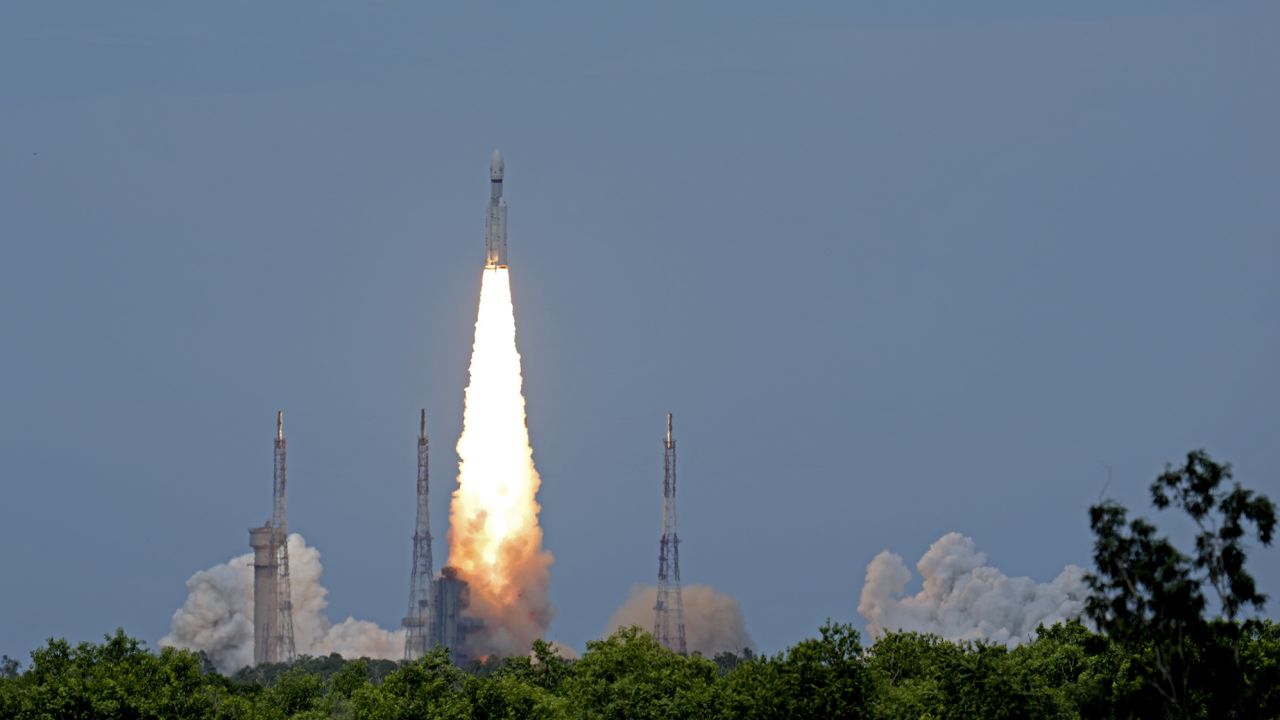Chandrayaan-3 Update In a significant update on the lunar mission, the Indian spacecraft has entered into lunar orbit after a journey of twenty-three days. As the spacecraft started circling the moon, it began transmitting signals to the Mission Operators Complex (MOX) at the ISRO Telemetry, Tracking and Command Network (ISTRAC). In the present status of the mission, it had included itself into an elliptical orbit around the moon, situated approximately 18,074 km from the lunar surface at its farthest point and 164 km at its nearest, where the mission is aimed at achieving an altitude of 100 km x 100km above the moon’s surface.
Chandrayaan-3
Chandrayaan-3 news

On 14 July, the Indian Space Research Organisation (ISRO) launched Chandrayaan-3 – a Moon mission featuring a lunar lander and a rover that will spend 14 days carrying out scientific activities on the surface. In addition to ISRO’s own deep space communication antenna, the mission relies on support from ground stations around the world, coordinated by ESA and NASA. Recently India is trying to 4th country to execute a controlled landing on lunar space Chandrayaan, which means “moon vehicle” in Sanskrit, blasted off from the Satish Dhawan Space Center at Sriharikota in southern Andhra Pradesh state just after 2:30 p.m. local time (5 a.m. ET). On Twitter, ISRO confirmed the Chandrayaan-3 is in “precise orbit” and has “begun its journey on the moon.”They also added that the health of the spacecraft is “normal
Chandrayaan 3 specification
| Sl No. | Parameter | Specifications |
|---|---|---|
| 1. | Mission Life (Lander & Rover) | One lunar day (~14 Earth days) |
| 2. | Landing Site (Prime) | 4 km x 2.4 km 69.367621 S, 32.348126 E |
| 3. | Scientific Payloads | Lander: Radio Anatomy of Moon Bound Hypersensitive ionosphere and Atmosphere (RAMBHA)Chandra’s Surface Thermophysical Experiment (ChaSTE)Instrument for Lunar Seismic Activity (ILSA)Laser Retroreflector Array (LRA) Rover: Alpha Particle X-Ray Spectrometer (APXS)Laser Induced Breakdown Spectroscope (LIBS) Propulsion Module: Spectro-polarimetry of HAbitable Planet Earth (SHAPE) |
| 4. | Two Module Configuration | Propulsion Module (Carries Lander from launch injection to Lunar orbit)Lander Module (Rover is accommodated inside the Lander) |
| 5. | Mass | Propulsion Module: 2148 kgLander Module: 1752 kg including Rover of 26 kgTotal: 3900 kg |
| 6. | Power generation | Propulsion Module: 758 WLander Module: 738W, WS with BiasRover: 50W |
| 7. | Communication | Propulsion Module: Communicates with IDSNLander Module: Communicates with IDSN and Rover. Chandrayaan-2 Orbiter is also planned for a contingency link. Rover: Communicates only with Lander. |
| 8. | Lander Sensors | Laser Inertial Referencing and Accelerometer Package (LIRAP)Ka-Band Altimeter (KaRA)Lander Position Detection Camera (LPDC)LHDAC (Lander Hazard Detection & Avoidance Camera)Laser Altimeter (LASA)Laser Doppler Velocimeter (LDV)Lander Horizontal Velocity Camera (LHVC)Micro-Star sensorInclinometer & Touchdown sensors |
| 9. | Lander Actuators | Reaction wheels – 4 nos (10 Nms & 0.1 Nm) |
| 10. | Lander Propulsion System | Bi-Propellant Propulsion System (MMH + MON3), 4 nos. of 800 N Throttleable engines & 8 nos. of 58 N; Throttleable Engine Control Electronics |
| 11. | Lander Mechanisms | Lander leg over Ramp (Primary & Secondary)RoverILSA, Rambha & Chaste PayloadsUmbilical connector Protection Mechanism, X- Band Antenna |
| 12. | Lander Touchdown specifications | Vertical velocity: ≤ 2 m / secHorizontal velocity: ≤ 0.5 m / secSlope: ≤ 120 |
Timeline of the mission
- On 6 July, ISRO said that Mission Chandrayaan-3 will be launched on 14 July from the second launch pas, Sriharikota.
- On 7 July, Vehicle electrical tests completed
- On 11 July, the ‘Launch Rehearsal’ simulating the entire launch operation and process lasting 24 hours concluded.
- On 14 July, LVM3 M4 vehicle successfully launched Chandrayaan-3 into orbit
- On 15 July, the first orbit-raising manoeuvre (Earthbound firing-1) was successfully performed at ISTRAC/ISRO, Bengaluru. Spacecraft was 41762 km x 173 km orbit.
- On 17 July, The second orbit-raising manoeuvre was performed. The Chandrayaan-3 spacecraft was in 41603 km x 226 km orbit.
- On 22 July, the fourth orbit-raising manoeuvre (Earth-bound perigee firing) was completed. The spacecraft was in a 71351 km x 233 km orbit.
- On 25 July, an Orbit-raising manoeuvre performed
- On 1 August, Chandrayaan-3 was inserted into the translunar orbit. The orbit achieved was 288 km x 369328 km
- On 5 August, Chandrayyan-3 was successfully inserted into the lunar orbit. The orbit achieved is 164 km x 18074 km, as intended.
Indian Chandrayaan-3 mission
When did Chandrayaan-3 enter moon orbit?
The Indian Space Research Organisation (ISRO) on August 5 completed the Lunar-Orbit Insertion (LOI) to successfully put the Chandrayaan-3 spacecraft into the moon’s orbit. The LOI manoeuvre was performed from ISRO Telemetry, Tracking and Command Network (ISTRAC) in Bengaluru. LOI manoeuvre commenced at 7 p.m.
What 3 lunar components did Chandrayaan-2 have?
Chandrayaan-2 consists of a lunar orbiter, a lander, and the Pragyan rover, in the recent Chandrayaan 3 mission
- Friday Night Plan Hindi Movie Teaser ( Experience the duo of brother friendship)
- Article 21 Malayalam Movie Review ( What is the price of education for all)
- Hindi Sexy Video (हिंदी सेक्सी वीडियो) Top 9 Sexy Video Hindi
- Israel’s Defense Ministry Fires ORON Aircraft
- Unknown: Cave of Bones review ( Who is the real history of humankind)

